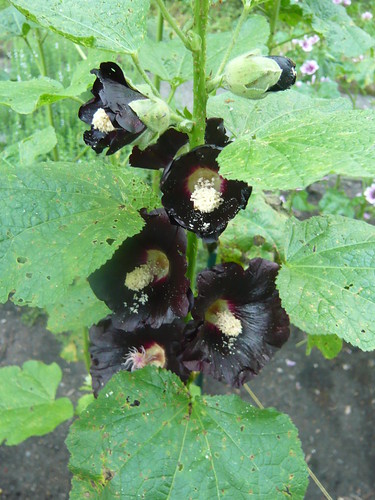Giant Black Hollyhocks

Elegant Hollyhocks can grow and flower up to 9 feet tall on slender stalks that do not take up too much space. Cottage gardens thrived on the added height that Hollyhocks provide and many old varieties survive close to walls in these gardens.
General Tips on Hollyhocks
- Hollyhocks like a moist soil but a dry air to avoid rust. Only water at the base of the plant.
- The top half of the Hollyhock bears a spike of large showy flowers either single, semi-double as well as double.
- If growing from seed use the freshest seed you can get. I sow in summer after flowers have set seed but you can wait until May the following year.
- Hollyhocks are perennial (although I treat them as biennials) and if they stay free of Rust Virus (and some are better than others at this) then you can take cuttings or divide the plants to get more stock.
- Fertilise a couple times during the early part of the season with a general purpose fertiliser.
- When the 3-4 inch flowers fade cut them down to the ground.
- Seeds can be found under the name Althaea rosea in self colours of white, yellow, rose, scarlet and black.
- The distinguishing feature of Hollyhocks are the 5 inch saucer shaped flowers growing on stalks up to 8 feet tall.
- They are well known in Cottage garden designs as they provide height and focal points.
- Hollyhocks are known and often sold by their Latin names Alcea Rosea or Althaea
- Flowers are single in a range of colours from red almost black through pinks rose to white and yellow There is a pompom type double called Chater’s mixture
- Hollyhocks are best if sown from fresh seed in late summer. The plants may be treated as biennials though they are hard perennials that have a shortish life. If sown in spring they may not flower until the next season.
- Keep seeds and seedlings watered and encourage good root formation
- Don’t compost leaves as they may have rust. Keep plants tidy by cutting leaves and spent blooms with secateurs.
- Dead heading may help a second flush of flowers